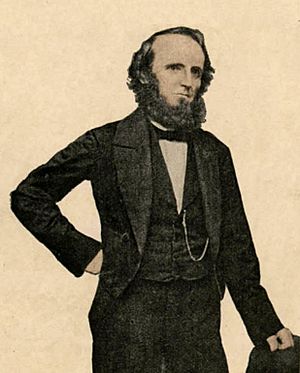Gamaliel Bailey facts for kids
Gamaliel Bailey (born December 3, 1807 – died June 5, 1859) was an American doctor. He chose to leave medicine to become a journalist. He was a strong supporter of the movement to end slavery, known as abolitionism. Bailey worked as an editor and publisher. He mainly worked in Cincinnati and Washington, D.C.. Groups of people who were against abolitionism attacked his offices in both cities during the 1840s.
Contents
Early Life and Education
Gamaliel Bailey was born in 1807 in Mount Holly, New Jersey. When he was nine years old, his family moved to Philadelphia. He received his education at home and in local schools.
In 1827, Bailey completed his medical studies. He graduated from the Jefferson Medical College in Philadelphia. After that, he moved to Baltimore. There, he worked as an editor for a religious newspaper called the Methodist Protestant.
Becoming an Abolitionist
In 1831, Bailey moved to Cincinnati. He started his own medical practice there. He also gave talks about how the body works (physiology) at the Lane Theological Seminary. In 1834, he attended important discussions at the seminary. These discussions were about slavery. After hearing both sides, Bailey became a very strong supporter of ending slavery. Students who were against slavery left the seminary because it did not support their views.
Fighting Slavery with Words
In 1836, Bailey joined James G. Birney to help run The Philanthropist. This was the official newspaper of the Ohio Anti-Slavery Society. The next year, Bailey took over as the main editor. He continued to publish articles against slavery until 1847. This was a dangerous job. The newspaper's printing office was destroyed three times by angry groups of people who supported slavery.
Starting in 1843, Bailey also edited a daily newspaper called the Herald. In 1847, he took charge of a new abolitionist newspaper. It was called The National Era and was based in Washington, D.C. His offices were attacked again by pro-slavery mobs. In 1848, he and his printers were trapped for three days by one of these mobs. This newspaper became very popular across the country. From 1851 to 1852, it published Harriet Beecher Stowe's famous book, Uncle Tom's Cabin, in parts.
Supporting the Dred Scott Case
In December 1854, Bailey helped convince Montgomery Blair to take on a very important court case. This was the Dred Scott case. Bailey agreed to pay for Blair's expenses. By May 1857, the case had cost money for court fees and printing documents. Bailey asked 75 members of Congress to each give $2.00. He paid for the rest of the costs himself.
Later Life and Legacy
In 1859, Gamaliel Bailey died at sea. He was 51 years old. He was traveling to Europe on a steamship called the Arago. His body was first buried in Congressional Cemetery in Washington, D.C. His wife, Margaret Lucy Shands Bailey, died in 1888. She was buried in Oak Hill Cemetery. Later, Bailey's son, Marcellus, had his father's remains moved. He reburied them next to his mother in an unmarked grave.


